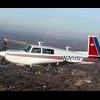For me, if I hear the current winds being called at a level that gives a crosswind component approaching 20 knots (including gusts) it gets my attention to prepare for a possible go-around situation. Similar to other posters above, I fly down final in a crab, transitioning to the conventional side slip (smoothly adding rudder to align the airplane with the runway with coordinated aileron input as necessary to eliminate drift) on short final approaching the flare. If I could not hold the airplane aligned with the runway with up to full rudder, then I would execute a go-around, and if necessary, divert to my "wind" alternate. Also, many times due to location of wind equipment, the actual conditions in the flare over the runway are far less challenging than the reported winds might indicate. Of course the opposite may occur also...ya gotta be ready. But, I would in most cases, give it a responsible look-see. I think the discussion about forward slips is a bit of a red-herring here. Forward slips have never been recommended as a crosswind technique; and as Bob Kromer mentioned, the longer body Mooneys (K and higher)..can get you in trouble at slow speed/high angles-of-attack. As a side note here, I have only utilized/taught forward slips during simulated/actual engine-out landings when EXCESSIVELY HIGH and all other drag options have been exhausted (full flaps, speed brakes) to get the airplane to touchdown and land successfully in the forced-landing site. Also, I emphasize "burying the nose" and keeping the speed up when accomplishing them in a M20J or earlier airframe (not K or later unless the alternative to not using the forward slip was unacceptable, ie. certain death) Bill CFII, ATP

